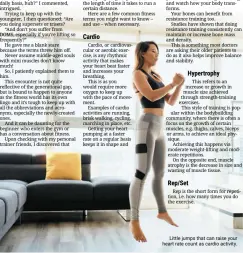To navigate the fitness world, it helps to have knowledge of certain terms and acronyms.
When it comes to strength training, using your bodyweight to perform the exercise is adequate for beginners. — Photos: 123rf.com
On your active recovery day, gentle stretching is a good way to relax the body.

Little jumps that can raise your heart rate count as cardio activity.
GYM-GOERS and some personal trainers like to throw jargon and acronyms around, even if they may not fully understand what the terms mean.
A few months ago, I met a college-going chap who had just started lifting weights and I queried him on his workout regime.
Most of his knowledge was taken off the internet – he was working out his arms and legs on alternate days six days a week, and looking tired, but good.
“I’m setting a PR every day,” he proudly told me.
PR? I was puzzled (I’m old school) and asked what that was because I only knew of PB (personal best).
The PR that I’m familiar with is the abbreviation for public relations – after all, as media practitioners, we frequently deal with PR professionals.
“Personal record, aunty!” he said, smiling while wondering which era I came from.
“Oh, that’s possible to do on a daily basis, huh?” I commented, intrigued.
Trying to keep up with the youngster, I then questioned: “Are you doing supersets or trisets?
“And don’t you suffer from DOMS, especially if you’re lifting so frequently?”
He gave me a blank stare because the terms threw him off.
Never assume middle-aged souls with mini muscles don’t know much!
So, I patiently explained them to him.
This encounter is not quite reflective of the generational gap, but is bound to happen to anyone as the fitness world has its own lingo and it’s tough to keep up with all the abbreviations and acronyms, especially the newly-created ones.
And it can be daunting for the beginner who enters the gym or has a conversation about fitness.
Upon checking with my personal trainer friends, I discovered that PR (the fitness acronym) is gym lingo that can be used for any kind of fitness activity.
It is, however, normally associated with the heaviest weight you’ve lifted for a particular exercise, or the maximum number of repetitions you performed using a certain weight.
People usually toss around this acronym when speaking about big lifts.
There are no hard and fast rules over using PR, but some people substitute it for PB.
They also use it to refer to other isolation exercises such as biceps curls, jump height, sprints, or even the length of time it takes to run a certain distance.
Here are a few common fitness terms you might want to know – and use – when necessary.
Cardio
Cardio, or cardiovascular or aerobic exercise, is any rhythmic activity that makes your heart beat faster and increases your breathing.
This is as you would require more oxygen to keep up with the pace of movement.
Examples of cardio activities are running, brisk walking, cycling, marching in place, etc.
Getting your heart pumping at a faster rate on a regular basis keeps it in shape and healthy, thus reducing the risk of heart disease.
The role of cardio exercises is to help burn calories so that you can shed weight.
Strength/resistance training
This form of exercise is intended to increase muscular strength and endurance.
It involves exercising muscles using some form of resistance, i.e. weights, bands, or even your own bodyweight working against gravity.
To lose weight faster, combine your cardio with strength training, and watch how your body transforms.
Your bones can benefit from resistance training too.
Studies have shown that doing resistance training consistently can maintain or increase bone mass and density.
This is something most doctors are asking their older patients to do as it also helps improve balance and stability.
Hypertrophy
This refers to an increase or growth in muscle size achieved through strength-training exercises.
This style of training is popular within the bodybuilding community, where there is often a focus on the growth of certain muscles, e.g. thighs, calves, biceps or arms, to achieve an ideal physique.
Achieving this happens via moderate weight-lifting and moderate repetitions.
On the opposite end, muscle atrophy is the decrease in size and wasting of muscle tissue.
Rep/set
Rep is the short form for repetition, i.e. how many times you do the exercise.
One rep means one time, two reps mean two times, and so on.
The term “set” tells you how many times you are to repeat a particular number of repetitions of a given exercise.
For example, if you are doing squats, saying three sets of 15 reps means you’ll be doing 15 squats three times in total, with a rest (for an allotted time, perhaps 30 seconds or a minute) in between sets.
Supersets/trisets/giant sets
Supersets are doing two exercises back to back with no break.
Giant sets are doing four or more exercises back to back with no break.
During these sets, you can either pair exercises that are non-competing, i.e. opposing muscle groups, or you can target the same muscle.
For example, you may do one set of 12 reps of chest presses, followed by another set of 12 reps of push-ups.
This is a superset exercising the same muscle group.
Or you may do one set of 12 reps of push-ups, followed by another set of 12 reps of squats, then another set of 12 reps of calf raises.
This is a triset exercising different muscle groups.
DOMS
All of us experience DOMS, or delayed onset muscle soreness, at some point from doing any activity that is either new, done for a longer duration, and/or at a harder intensity.
It’s caused by inflamed muscle and connective tissues.
Symptoms range from muscle tenderness or soreness, to severe debilitating pain.
The temporary discomfort starts a day or two after a workout, and eases off by day three or four.
The soreness is a sign that your muscles have been worked and your fitness is progressing, but you shouldn’t be getting DOMS after every workout unless you’re exercising only once a month!
HIIT
High intensity interval training (HIIT) is a form of cardio exercise characterised by short periods of all-out exercise, interspersed with rest or active recovery sessions.
It combines both cardio and strength training, with the intention to maximise athletic performance.
It incorporates several rounds that alternate between several minutes of high intensity movements to significantly increase the heart rate to at least 80% of one’s maximum heart rate, followed by short periods of lower intensity movements.
There is a ratio that is followed, i.e. the amount of time spent working versus the amount of time spent recovering – also known as the work-to-recovery ratio.
For example, when you perform 60 seconds of work, followed by 60 seconds of recovery, your HIIT ratio is one-to-one.
Tabata
This is another form of HIIT consisting of short workout blocks.
Tabata training breaks a workout down into clearly defined intervals – typically, 20 seconds of a push-it-to-the-limit exercise, followed by 10 seconds of rest.
One cycle is repeated eight times for a total of four minutes.
You can mix two exercises in a cycle, e.g. 20 seconds jumping jacks, 10 seconds rest, 20 seconds crunches, 10 seconds rest, then repeat.
The recommendation is to do four to five cycles for a 16-20 minutes’ workout – you’ll be sweating buckets by then!
Tabata, founded by Japanese scientist Izumi Tabata, is a highly effective training style for building power and cardiovascular fitness.
However, bear in mind that Tabata is gruelling and you’ll need to be fit enough to meet its physical demands without getting injured.
Also note that Tabatha is HIIT, but not all HIIT is Tabata.
Active rest or recovery
This is usually one day in a set time period when you give your body a “break” and do some sort of movement that is less intense than your regular workout days.
But this does not mean you can lounge on the couch or scroll through social media throughout the day.
Instead, active rest means scheduling a low-intensity activity like a leisurely stroll, foam-rolling or gentle yoga to help with circulation.
You can even opt for a massage. Your body needs time to recover (just like the mind needs to recharge) so that the muscles can rebuild stronger.
 By Revathi Murugappan, a certified fitness trainer who tries to
battle gravity and continues to dance to express herself artistically and nourish her soul. For more information, email starhealth@thestar.com. my. The information contained in this column is for general educational purposes only. Neither The Star
nor the author gives any warranty on accuracy, completeness, functionality, usefulness or other assurances as to such information. The Star and the author disclaim all responsibility for any losses, damage to property or personal injury suffered directly or indirectly from reliance on such information.
By Revathi Murugappan, a certified fitness trainer who tries to
battle gravity and continues to dance to express herself artistically and nourish her soul. For more information, email starhealth@thestar.com. my. The information contained in this column is for general educational purposes only. Neither The Star
nor the author gives any warranty on accuracy, completeness, functionality, usefulness or other assurances as to such information. The Star and the author disclaim all responsibility for any losses, damage to property or personal injury suffered directly or indirectly from reliance on such information.
Related posts:


![]() / actdottv
Twitch: https://www.twitch.tv/actdottv
@actdottv
#DoMoreThanWatch
/ actdottv
Twitch: https://www.twitch.tv/actdottv
@actdottv
#DoMoreThanWatch





























